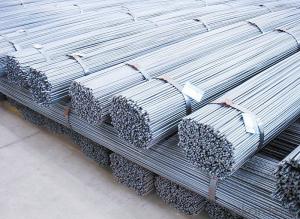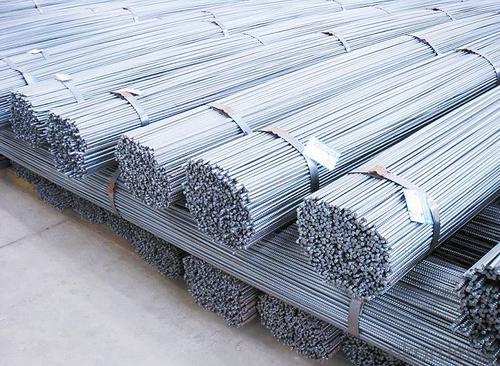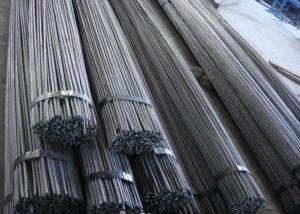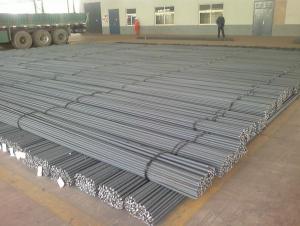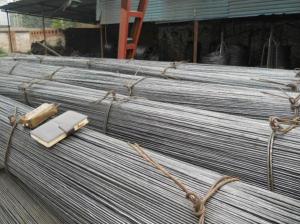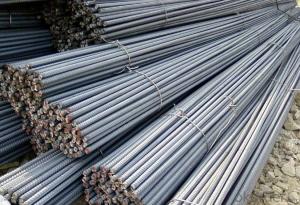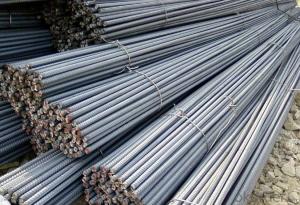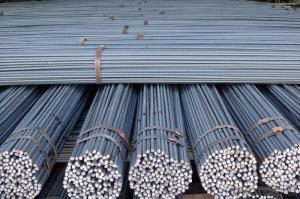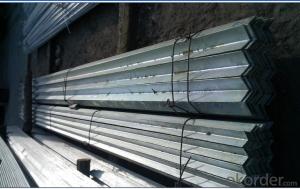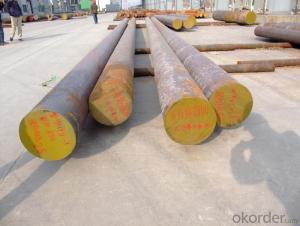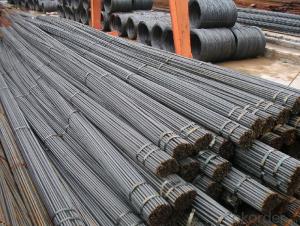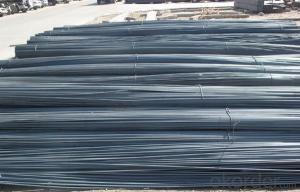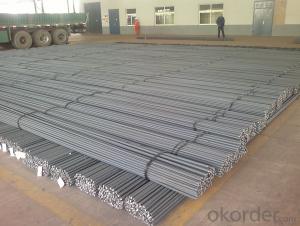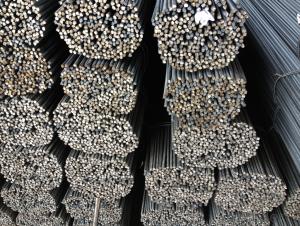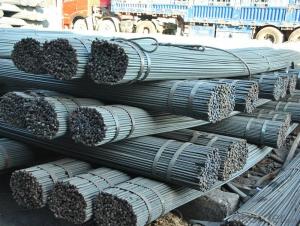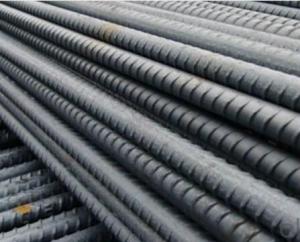Favorites Compare Steel Rebar, Deformed Steel Bar, Iron Rods For Construction
- Loading Port:
- Shanghai
- Payment Terms:
- TT OR LC
- Min Order Qty:
- 100 m.t.
- Supply Capability:
- 1000 m.t./month
OKorder Service Pledge
OKorder Financial Service
You Might Also Like
deformed steel bar grade 40
material: HRB400, BS4449 GR460B
size: 8-36mmx12m.
short delivery time by bulk or container
deformed steel bar grade 40
material: HRB400, BS4449 GR460B
size: 8-36mmx12m.
short delivery time with bulk or container
packing: Mill standard export packing in bundles/coil, around 2tons/bundle.
country of Origin: China
delivery Time: Within a 35 days
Shipment: by bulk vessel or by container
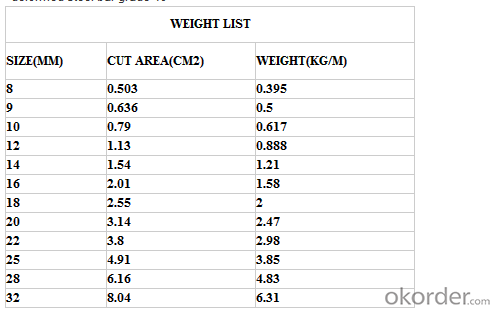
Leading goods:
section steel:angles,channels,I-beam,H-beam;
coils:cold/hot rolled coils,PPGI,galvanized coils,plate,checkered plate,cutting steel plate,steel strip;
wire rod:steel wire,deformed wire,bar;
pipe:seamless pipe,rectangular pipe,welded pipe,spiral welded pipe,pipe fittings;
stainless steel:steel sheets,stainless steel strips,stainless bar,stainless tube;
special:weathering steel,shipbuilding steel;
construction steel:C-channel,Z-channel,T-bar,high-speed divider plate,corrugated steel plate,steel grating.
Advantage:
We are the spot supplier, Six huge warehouses which can hold 20,000 MT goods.
It makes the cost lower than others,we can provide the competitive price for you.
Delivery time:
Normal sizes can be provided in 7days, the others should be ready in 30---45 days.
Further treatment:
We can offer cutting,painting,drilling holes,bending,threading, welding,galvanization,packing etc.
Security interest:
We have already passed the ISO9001, BV and SGS authentication which makes the quality secured.
If you have the interest in any of the products we can provided, pls don't hesitate to connect with me. Looking forward to cooperate with you.
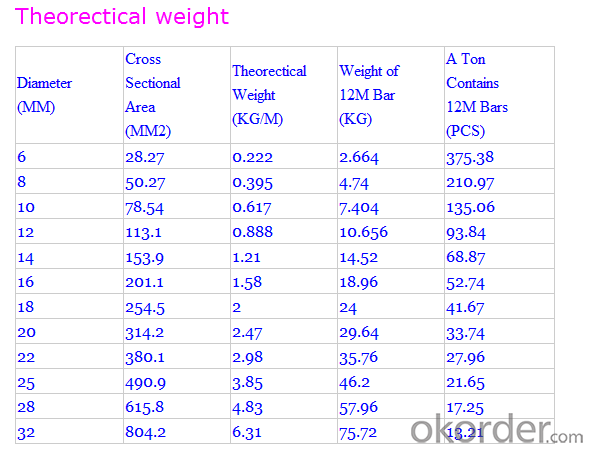
FAQ of Steel Deformed Bar
1. More than 10 years experience in this industry
2. 100,000 tons exporting per month
3. Professional foreign trade tea
4. OEM&ODM capacity
5. High quality assured & competitive price
6. Try our best to meet your needs & save your budget
7. Very popular in Southeast Asia, Africa, Mid-East and South America etc.
8. VIP membership system, first time customers and long-term cooperation customers can get extra discount on some products.
- Q: How are steel rebars protected during the concrete pouring process?
- During the concrete pouring process, steel rebars are protected in several ways to ensure their longevity and structural integrity. Firstly, before the concrete is poured, the rebars are carefully cleaned to remove any rust, dirt, or other contaminants that could compromise the bond between the rebar and the concrete. This is typically done by using a wire brush or other mechanical means. Once the rebars are cleaned, they are usually coated with a protective layer or coating. One common method is to apply an epoxy coating to the rebars. This coating acts as a barrier, preventing moisture and chemicals from reaching the steel and causing corrosion. Epoxy coatings are often used in high-risk environments such as marine structures or areas with high chloride content. Another method of protection involves using corrosion inhibitors. These inhibitors are added to the concrete mix, which then forms a protective layer around the rebars. The inhibitors work by reducing the corrosive effects of chloride ions, oxygen, and other chemicals that could lead to corrosion. Additionally, during the pouring process, it is important to ensure proper concrete cover over the rebars. Concrete cover refers to the thickness of the concrete layer between the surface and the rebar. Adequate concrete cover helps protect the rebars from exposure to moisture, chemicals, and other environmental factors. To achieve the required concrete cover, steel stirrups or spacers are placed around the rebars to maintain a specific distance between the rebar and the formwork. This ensures that the concrete is evenly distributed around the rebars, providing them with the necessary protection. In summary, steel rebars are protected during the concrete pouring process through various methods such as cleaning, applying protective coatings, using corrosion inhibitors, and maintaining proper concrete cover. These measures help to prevent corrosion and ensure the durability and strength of the reinforced concrete structure.
- Q: What is the ductility of steel rebars?
- The ductility of steel rebars refers to their ability to deform and stretch without breaking during tension or bending. Steel rebars are known for their excellent ductility, which allows them to absorb and dissipate energy when subjected to high loads or seismic forces. This property is essential in construction, as it ensures that the rebars can withstand extreme conditions and maintain structural integrity. The ductility of steel rebars also makes them suitable for various applications, such as reinforcing concrete structures and providing support in buildings, bridges, and other infrastructure projects.
- Q: Excuse me, the difference between round steel, screw steel, steel, plate material, steel wire, hope professional answer
- Anything you say can be called steel bar, except steel wire. Round and round is a name, and wire coil, general line.
- Q: Can steel rebars be used in the construction of power plants or industrial facilities?
- Yes, steel rebars can be used in the construction of power plants or industrial facilities. Steel rebars are extremely strong and durable, making them an ideal choice for reinforcing concrete structures in these types of facilities. They provide the necessary strength and support to withstand heavy loads, vibrations, and extreme temperatures that are often encountered in power plants and industrial facilities. Additionally, steel rebars are resistant to corrosion, which is crucial in these environments where exposure to moisture, chemicals, and other harsh elements is common. Therefore, steel rebars are commonly used in the construction of power plants and industrial facilities to ensure the structural integrity and longevity of the buildings.
- Q: What's the difference between round bar and screw steel? Which one is cheaper on the market at present?
- Steel is known as hot rolled ribbed bar. The specification of rebar is large, and it belongs to small section steel. It is mainly used for the skeleton of reinforced concrete construction component. Generally required in the use of a certain mechanical strength, bending deformation properties and welding process performance.
- Q: What are the guidelines for protecting steel rebars during concrete placement and compaction?
- To ensure the structural integrity and durability of the concrete structure, it is essential to adhere to guidelines for safeguarding steel rebars during concrete placement and compaction. Here are some key guidelines to consider: 1. Covering and Support: Adequate coverage and support are necessary to shield rebars from corrosion and damage. The minimum cover requirements specified in the design or relevant standards must be met. Additionally, rebars should be positioned accurately, avoiding direct contact with the ground or formwork. 2. Cleanliness: Prior to concrete placement, thorough cleaning of rebars is crucial to eliminate rust, scale, dirt, or other contaminants. This can be achieved through wire brushing, sandblasting, or other appropriate methods. Clean rebars promote better bonding with the concrete and reduce the risk of corrosion. 3. Moisture Control: During concrete placement and compaction, rebars should remain dry. Excessive moisture, particularly in high humidity or chloride-exposed areas, can accelerate corrosion. To prevent moisture accumulation, proper drainage systems and the use of waterproofing membranes are recommended. 4. Spacing and Tying: Adequate spacing and tying of rebars are necessary to maintain the desired concrete cover and prevent displacement during placement and compaction. This ensures proper embedding of rebars in the concrete, providing the required structural strength. 5. Vibrating and Compaction: Care should be taken to avoid direct contact between the vibrator and rebars during concrete placement, as this can cause damage or displacement. Vibrating should be done carefully and gradually to ensure uniform and tight compaction of the concrete around the rebars. 6. Concrete Placement Techniques: Proper techniques for concrete placement should be followed to minimize the risk of rebar displacement. Gentle and even placement of concrete should be prioritized, avoiding excessive dropping or splashing that could displace rebars. Additionally, proper compaction and consolidation techniques should be employed to eliminate voids and fully encapsulate rebars. 7. Protection from External Factors: Rebars should be protected from environmental factors that can induce corrosion, such as moisture, chemicals, or aggressive soils. Adequate curing of the concrete is vital to prevent rapid drying or carbonation, which can lead to corrosion and reduced durability. By adhering to these guidelines, rebars can be effectively protected during concrete placement and compaction, ensuring the long-lasting and safe nature of the concrete structure. It is advisable to consult relevant design codes, specifications, and industry best practices for project-specific guidelines.
- Q: What is the role of steel rebars in the construction of water storage tanks?
- The role of steel rebars in the construction of water storage tanks is to provide structural reinforcement and enhance the overall strength and durability of the tank. The rebars, which are typically made of high-strength steel, are embedded within the concrete walls or floors of the tank to counteract tensile forces and prevent cracking or deformation. This reinforcement ensures that the tank can withstand the weight of the stored water, external pressures, and potential seismic activity, ensuring the long-term integrity and safety of the structure.
- Q: What are the guidelines for preventing steel rebars from rusting during construction delays?
- To prevent steel rebars from rusting during construction delays, it is important to follow some guidelines: 1. Proper Storage: Store the rebars in a covered and dry area away from moisture and direct sunlight. The storage area should be well-ventilated to prevent condensation. 2. VCI (Volatile Corrosion Inhibitor) Products: Use VCI products such as VCI paper, films, or emitters. These products release corrosion-inhibiting chemicals that create a protective layer on the rebars, preventing rust formation. 3. Proper Packaging: If rebars are being transported or stored for an extended period, ensure they are properly packaged. Wrap the rebars tightly with VCI paper or plastic sheets, and secure the packaging with tape to prevent moisture ingress. 4. Dehumidification: Use dehumidifiers in areas where the rebars are stored to reduce humidity levels. This helps in maintaining the dryness of the surrounding environment and prevents condensation on the rebars. 5. Regular Inspection: Periodically inspect the rebars for any signs of rust formation. If rust is detected, it should be immediately cleaned and treated with anti-corrosion coatings to prevent further damage. 6. Protective Coatings: Apply anti-corrosion coatings on rebars to provide an additional protective layer. These coatings can be epoxy-based or zinc-based, depending on the environmental conditions and project requirements. 7. Remove Standing Water: Ensure that there is no standing water near the rebars, as it can accelerate the rusting process. Proper drainage systems should be in place to prevent water accumulation. 8. Monitoring: Regularly monitor the environmental conditions, including temperature and humidity levels, to identify any potential risks for rust formation. Adjust the storage conditions accordingly, if needed. By following these guidelines, construction delays can be managed effectively, and the steel rebars can be protected from rust formation, ensuring the structural integrity of the project.
- Q: How do steel rebars affect the overall sustainability certifications of a structure?
- Steel rebars can have a significant impact on the overall sustainability certifications of a structure. Sustainability certifications, such as LEED (Leadership in Energy and Environmental Design) or BREEAM (Building Research Establishment Environmental Assessment Method), evaluate the environmental performance of a building based on various factors, including the materials used. When it comes to steel rebars, their production and use can influence the sustainability of a structure in several ways. Firstly, the production of steel involves significant energy consumption and greenhouse gas emissions. However, many steel manufacturers have implemented energy-efficient technologies and utilize recycled materials to minimize their environmental footprint. Therefore, the sustainability of steel rebars largely depends on the production methods and the extent to which recycled content is used. Furthermore, the durability and longevity of steel rebars play a crucial role in the sustainability of a structure. Steel is known for its strength and resilience, which can significantly enhance the lifespan of a building. This reduces the need for frequent repairs and replacements, thereby reducing material waste and energy consumption associated with ongoing maintenance. Additionally, steel rebars can contribute to the overall structural efficiency of a building. By reinforcing concrete, they improve the structural integrity and load-bearing capacity, allowing for more efficient use of materials. This can lead to reduced material consumption and waste during construction, which is an essential aspect of sustainability. Moreover, steel rebars can be recycled at the end of a building's life cycle. Steel is a highly recyclable material and can be repurposed into new rebars or other steel products, reducing the demand for virgin materials. This recycling process further minimizes the environmental impact associated with steel production. In summary, steel rebars can affect the overall sustainability certifications of a structure through various factors, including the production methods, durability, structural efficiency, and recyclability. By using sustainable production methods, enhancing durability, optimizing material usage, and promoting recycling, steel rebars can contribute positively to the sustainability of a building and help achieve higher sustainability certifications.
- Q: How do steel rebars affect the overall seismic performance of a structure?
- Steel rebars play a crucial role in enhancing the overall seismic performance of a structure. Seismic events such as earthquakes exert dynamic forces on buildings, causing them to vibrate and potentially collapse. However, the inclusion of steel rebars in concrete structures significantly improves their ability to withstand such forces and ensures the safety of the occupants. Firstly, steel rebars enhance the structural integrity of a building. By reinforcing the concrete, they increase its tensile strength, as concrete alone is weak in tension. During an earthquake, the rebars help distribute the dynamic forces throughout the structure, preventing the concentration of stress on specific areas. This redistribution of forces minimizes the risk of localized failures and ensures that the structure remains stable. Furthermore, steel rebars increase the ductility of the structure. Ductility refers to a material's ability to deform under stress without fracturing. During an earthquake, buildings experience significant lateral movements and deformations. Steel rebars, due to their high ductility, can elongate and stretch without breaking, absorbing and dissipating the seismic energy. This property allows the structure to withstand larger ground motions and reduces the possibility of sudden collapse. Additionally, steel rebars improve the overall resilience of a structure. Resilience refers to the ability of a building to quickly recover its functionality after an earthquake. By reinforcing the concrete, steel rebars contribute to the post-earthquake repairability of the structure. They ensure that the building maintains its load-carrying capacity even after suffering damages, which reduces downtime and allows for faster recovery. Moreover, steel rebars provide a warning sign of potential structural issues. During an earthquake, cracks may appear in the concrete, indicating areas of stress concentration. These cracks are often visible around the rebars, serving as an early indication of structural vulnerability. This visual warning allows for timely inspection and repair, preventing further damage and ensuring the long-term safety of the building. In conclusion, steel rebars play a vital role in enhancing the overall seismic performance of a structure. Their inclusion in concrete significantly improves the structural integrity, increases ductility, enhances resilience, and provides visual warnings of potential issues. By reinforcing the concrete, steel rebars ensure that buildings can withstand seismic forces, reducing the risk of collapse and ensuring the safety of occupants during earthquakes.
Send your message to us
Favorites Compare Steel Rebar, Deformed Steel Bar, Iron Rods For Construction
- Loading Port:
- Shanghai
- Payment Terms:
- TT OR LC
- Min Order Qty:
- 100 m.t.
- Supply Capability:
- 1000 m.t./month
OKorder Service Pledge
OKorder Financial Service
Similar products
Hot products
Hot Searches
Related keywords
